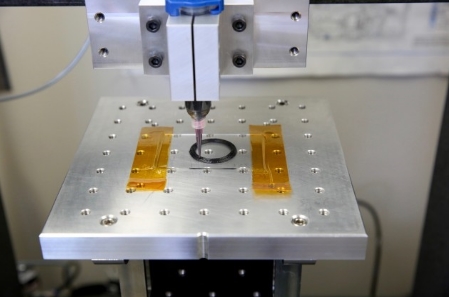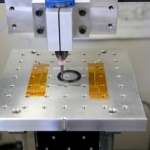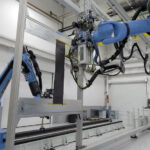Lawrence Livermore National Laboratory (LLNL) researchers have become the first to 3D print aerospace-grade carbon fiber composites, opening the door to greater control and optimization of the lightweight, yet stronger than steel material.
The research, published by the journal Scientific Reports online on March, represents a “significant advance” in the development of micro-extrusion 3D printing techniques for carbon fiber, the authors reported.
“The mantra is ‘if you could make everything out of carbon fiber, you would’ – it’s potentially the ultimate material,” explained Jim Lewicki, principal investigator and the paper’s lead author. “It’s been waiting in the wings for years because it’s so difficult to make in complex shapes. But with 3D printing, you could potentially make anything out of carbon fiber.”
Carbon fiber is a lightweight, yet stiff and strong material with a high resistance to temperature, making the composite material popular in the aerospace, defense and automotive industries, and sports such as surfing and motorcycle racing.
Carbon fiber composites are typically fabricated one of two ways — by physically winding the filaments around a mandrel, or weaving the fibers together like a wicker basket, resulting in finished products that are limited to either flat or cylindrical shapes, Lewicki said. Fabricators also tend to overcompensate with material due to performance concerns, making the parts heavier, costlier and more wasteful than necessary.
However, LLNL researchers reported printing several complex 3D structures through a modified Direct Ink Writing (DIW) 3D printing process. Lewicki and his team also developed and patented a new chemistry that can cure the material in seconds instead of hours, and used the Lab’s high performance computing capabilities to develop accurate models of the flow of carbon fiber filaments.
“How we got past the clogging was through simulation,” Lewicki said. “This has been successful in large part because of the computational models.”
Computational modeling was performed on LLNL’s supercomputers by a team of engineers who needed to simulate thousands of carbon fibers as they emerged from the ink nozzle to find out how to best align them during the process.
“We developed a numerical code to simulate a non-Newtonian liquid polymer resin with a dispersion of carbon fibers. With this code, we can simulate evolution of the fiber orientations in 3D under different printing conditions,” said fluid analyst Yuliya Kanarska. “We were able to find the optimal fiber length and optimal performance, but it’s still a work in progress. Ongoing efforts are related to achieving even better alignment of the fibers by applying magnetic forces to stabilize them.”
The ability to 3D print offers new degrees of freedom for carbon fiber, researchers said, enabling them to have control over the parts’ mesostructure. The material also is conductive, allowing for directed thermal channeling within a structure. The resultant material, the researchers said, could be used to make high-performance airplane wings, satellite components that are insulated on one side and don’t need to be rotated in space, or wearables that can draw heat from the body but don’t allow it in.
“A big breakthrough for this technology is the development of custom carbon fiber-filled inks with thermoset matrix materials,” said materials and advanced manufacturing researcher Eric Duoss. “For example, epoxy and cyanate ester are carefully designed for our printing process, yet also provide enhanced mechanical and thermal performance compared to thermoplastic counterparts that are found in some commercially available carbon fiber 3D printing technologies, such as nylon and ABS (a common thermoplastic). This advance will enable a broad range of applications in aerospace, transportation and defense.”
The direct ink writing process also makes it possible to print parts with all the carbon fibers going the same direction within the microstructures, allowing them to outperform similar materials created with other methods done with random alignment. Through this process, researchers said they’re able to use two-thirds less carbon fiber and get the same material properties from the finished part.
The researchers will next turn to optimizing the process, figuring out the best places to lay down the carbon fiber to maximize performance. There have been discussions with commercial, aerospace and defense partners to move forward on future development of the technology.
Other Lab researchers included on the paper are Jennifer Rodriguez, Cheng Zhu, Marcus Worsley, Amanda Wu, John Horn, Jason Ortega, William Elmer, Ryan Hensleigh, Ryan Fellini and Michael King.
The Laboratory Directed Research and Development program funded the study.
Caption: A carbon fiber composite ink extrudes from a customized direct ink writing (DIW) 3D printer, eventually building part of a rocket nozzle.













